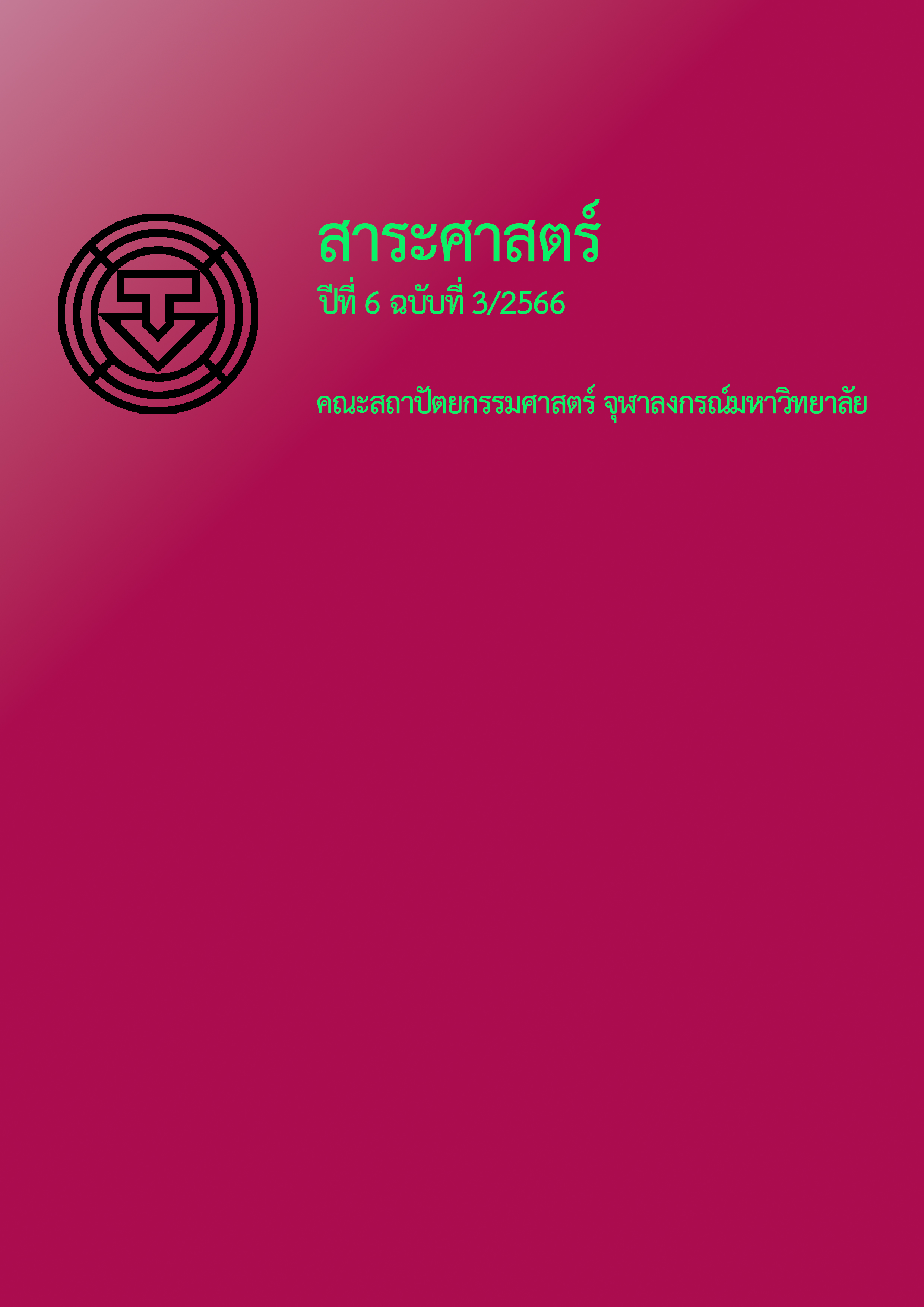The Breaking of the Gated Community Phenomenon: A Case Study in Lat Phrao District
Main Article Content
Abstract
The breaking of the gated community is a phenomenon caused by the development of gated communities. This study examines a phenomenon in Lat Phrao district and aims to 1) study common characteristics of the breaking of gated communities 2) present its effects through morphological study and 3) suggest the guidelines for future community development. This study applies data analytics with various statistics of each phenomenon to represent its characteristics and impacts on the urban context, user experience, and gated community itself.
The study suggests that the breaking of gated community phenomenon has impacts on the neighborhood context in two ways; the positive and negative effects. The phenomenon has a positive impact on the way in which the breaking gated community adds extra entrance which also implies that it increases potential accessibility and shorten the distance to access the facilities for people who live in gated communities, neighborhood, and passers. Moreover, it encourages an opportunity to generate secondary income for people who live in gated communities and neighborhoods. It also consequentially increases eyes on the street of people who live in gated communities. The phenomenon has a negative impact on the way in which it reduces the privacy of the inhabitant and raises traffic congestion, pollution, and incidents in the communities.
This study then proposes the development guidelines for a gated community as follows; The design of a gated community should increase the level of accessibility and permeable movement of the neighborhood. It also should establish the land-use diversity within the neighborhood as suggested through the complete neighborhood concept. The guidelines should include the built environment design guidelines and regulation of community planning in order to reduce incidents and traffic through movement.
Article Details
References
ข้อกำหนดเกี่ยวกับการจัดสรรที่ดินเพื่อการอยู่อาศัยและพาณิชยกรรมกรุงเทพมหานคร พ.ศ.2550. (2550, 23 กุมภาพันธ์). ราชกิจจานุเบกษา. เล่ม 124 ตอนพิเศษ 21 ง. หน้า 47-63.
ข่าวสดออนไลน์. (2565, 21 มกราคม). ข่าวในหน้า. ข่าวสด. https://www.khaosod.co.th/newspaper/newspaper-inside-pages/news_6846157
ไขศรี ภักดิ์สุขเจริญ. (2548). วาทกรรมของเมืองผ่านโครงสร้างเชิงสัณฐาน. วารสารวิชาการคณะสถาปัตยกรรมศาสตร์ จุฬาลงกรณ์มหาวิทยาลัย ฉบับภาควิชาการวางแผนภาคและเมือง, 1-14. http://readgur.com/doc/2205627/วาทกรรมของเมือง-ผ่านโครงสร้างเชิงสัณฐาน
ไขศรี ภักดิ์สุขเจริญ. (2552). กำแพงในซอยและรั้วในใจ การปรับแนวคิดในการฟื้นฟูเมือง. วารสารวิชาการคณะสถาปัตยกรรมศาสตร์ จุฬาลงกรณ์มหาวิทยาลัย, 2, 93-100. https://www.arch.chula.ac.th/journal/files/article /4vNNvNnyBsSun105353.pdf
พระราชบัญญัติการจัดสรรที่ดิน พ.ศ.2543. (2543, 4 พฤษภาคม). ราชกิจจานุเบกษา. เล่ม 117 ตอนที่ 45 ก. หน้า 1-21.
ว่าน ฉันทวิลาสวงศ์ และอดิศักดิ์ กันทะเมืองลี้. (2563, 1 กันยายน). มหานครซอยตัน. The Urbanis by UDDC. https://theurbanis.com/insight/01/09/2020/2651
สรวิศ รุ่งโรจนารักษ์. (2562). สัณฐานเมืองเพื่อการพัฒนาย่านสร้างสรรค์บางรัก กรุงเทพมหานคร [วิทยานิพนธ์ปริญญามหาบัณฑิต, มหาวิทยาลัยศิลปากร]. Silpakorn University Repository: SURE. http://www.sure.su.ac.th/xmlui/handle/123456789/904/discover
Bentley, I., Alcock, A., Murrain, P., McGlynn, S., & Smith, G. (1985). Responsive environments: A manual for designers. Routledge. https://nexosarquisucr.files.wordpress.com/2016/05/responsive_environments_by_ ian_bentley_et-_al.pdf
Blandy, S., Lister, D., Atkinson, R. & Flint, J. (2003). Gated communities: A systematic review of the research evidence. CNR paper, 12, 1-65. https://www.academia.edu/316535/Gated_Communities_A_ Systematic_Review_of_the_Research_Evidence
Dogan, O., Han, J., & Lee, S. (2021). Opening gated communities and neighborhood accessibility benefits: The case of Seoul, Korea. International Journal of Environmental Research and Public Health,18(8), 4255. https://doi.org/10.3390/ijerph18084255
Gaille, L. (2020). 18 advantages and disadvantages of a gated community. Vittana.https://vittana.org/18advantages-and-disadvantages-of-a-gated-community
Grant, J., & Mittelsteadt, L. (2004). Types of gated communities. Environment and Planning B: Planning and Design, 31(6), 913-930. https://doi.org/10.1068/b3165
Hillier, B., Penn, A., Hanson, J., Grajewski, T., & Xu, J. (1993). Natural movement: Or configuration and attraction in urban pedestrian movement. Environment and Planning B: Planning and Design, 20, 129-66.
Yamu, C., Van Nes, A., & Garau, C. (2021). Bill Hillier’s legacy: Space syntax—A synopsis of basic concepts,measures, and empirical application. Sustainability, 13(6), 3394. https://doi.org/10.3390/su13063394
Yang, S., Tan, W., & Yan, L. (2021). Evaluating accessibility benefits of opening gated communities for pedestrians and cyclists in China: A case study of Shanghai. Sustainability, 13(2), 598. https://doi.org/10.3390/su13020598


